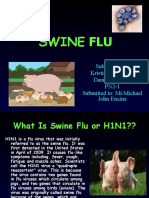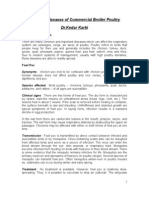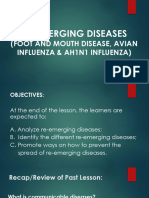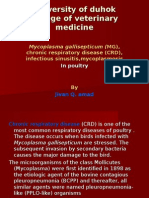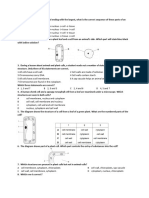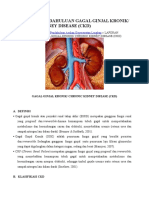Adrian Jess Galindo: Definition
Adrian Jess Galindo: Definition
Uploaded by
Adrian MangahasCopyright:
Available Formats
Adrian Jess Galindo: Definition
Adrian Jess Galindo: Definition
Uploaded by
Adrian MangahasOriginal Description:
Original Title
Copyright
Available Formats
Share this document
Did you find this document useful?
Is this content inappropriate?
Copyright:
Available Formats
Adrian Jess Galindo: Definition
Adrian Jess Galindo: Definition
Uploaded by
Adrian MangahasCopyright:
Available Formats
Adrian Jess Galindo
Definition:
Bird flu or Avian Influenza (A1) is a contagious disease of bird raging from mild to serve
form of illness.
Some forms of bird flu infections can cause illness to humans.
Bird flu is caused by an influenza A virus.
The outbreaks affecting some Asian countries have been caused by influenza A/H5N1
virus. It can also cause severe infection in humans.
Signs and Symptoms:
Symptoms in animals vary, but virulent strains can cause death within a few days.
The symptoms of avian influenza in humans following exposure to bird flue infected chicken
patient develops:
fever
body weakness or muscle pain,
sore throat
cough
sore eyes
difficulty of breathing
Etiologic Agent:
The causative agent is the avian influenza (A1) virus. A1 viruses all belong to the influenza virus,
a genus of the Orthomyxoviridae family and are negative-stranded, and segmented.
Modes of Transmission:
Avian influenza spreads in the air and in manure. Wild fowl often acts as resistant carrier
spreading it to more susceptible domestic stocks.
It can also be transmitted through contaminated feeds, water, equipment, and clothing
Cats are also thought to be possible infection vectors for H5N1 strains of avian flu.
While avian influenza spreads rapidly among birds, it does not infect humans easily, and
there is no confirmed evidence of human-to-human transmission. Of the 15 subtypes
known, only subtypes H5 and H7 are known to be capable of crossing the species barrier.
Incubation Period:
The incubation period is three to five days.
Period of Communicability
It is probably communicable for three to five days from clinical onset in adults and up to seven
days and occasionally longer in young children.
Clinical Manifestation
Respiratory distress, a hoarse voice, and a crackling sound when inhaling. Sputum production is
variable and sometimes bloody.
Diagnostic Procedure
Laboratory tests
Samples of fluids from your nose or throat can be tested for evidence of bird flu virus.
Imaging tests
X-rays
Adrian Jess Galindo
Treatment
Health officials recommend the use of oseltamivir (Tamiflu) or, if oseltamivir can't be used,
zanamivir (Relenza). These drugs must be taken within two days after the appearance of
symptoms.
Complications
People with bird flu may develop life-threatening complications, including:
Pneumonia
Collapsed lung
Respiratory failure
Kidney dysfunction
Heart problems
Prevention:
Avian influenza in humans can be detected reliably with standard influenza tests.
Antiviral drugs are clinically effective in both preventing and treating the disease.
Vaccines, however, taken at least four months to produce and must be prepared for each
subtype.
Wash hands thoroughly with soap and water before and after handling live and dressed
chicken.
Cook chicken thoroughly.
Do not sell live chickens and other birds in the market while there is a threat of bird flu.
Do not let chickens roam freely. Keep them in cages or pens.
Do not place chicken, ducks and pigs together in one area, cage or pen.
Do not catch, get near or keep in captivity wild birds.
Report to the nearest agricultural/veterinary office any unusual death or illness of
chickens and other birds.
Report to the nearest local health centers any case of respiratory illness with history of
exposure to sick or dead chickens and other birds.
Individuals at risk are those directly exposed to sick chicken and other birds. The
government thereby advises prospective travelers to countries affected with bird flu not to
go to bird parks, poultry farms and markets where live chicken and other birds are sold.
Nursing Management
Antivirals. Oseltamivir is the primary treatment of choice
Oxygen therapy. Monitor oxygen saturation and maintain SaO2 over 90% with nasal
cannulae or face mask.
Paracetamol given orally or by suppository will generally be sufficient in most cases as
an anti-pyretic treatment.
Whenever risk of infectious aerosols, use particulate respirator (N95, FFP2 or
equivalent), eye protection, gowns, gloves and an airborne precaution room or negative
pressure room
Avoid administration of salicylates (such as aspirin and aspirin containing products) in
children and young adults (<18 years old) because of the risk of Reye Syndrome.
You might also like
- AMOEBIASISDocument44 pagesAMOEBIASISJorge Rabaja100% (1)
- Scoring For POMSDocument1 pageScoring For POMSAdrian MangahasNo ratings yet
- Avian Influenza: CausesDocument5 pagesAvian Influenza: Causescornelia marianaNo ratings yet
- Avian Flu: Emerging IllnessesDocument11 pagesAvian Flu: Emerging IllnessesPrincess Aliah M. MaruhomNo ratings yet
- Bird FluDocument4 pagesBird Fluhatimkhankakar012No ratings yet
- Orthomyxoviridae Family of Viruses. Influenza Virus A Includes Only One Species: Influenza A Virus WhichDocument5 pagesOrthomyxoviridae Family of Viruses. Influenza Virus A Includes Only One Species: Influenza A Virus Whichapi-33708392No ratings yet
- Avian InfluenzaDocument20 pagesAvian InfluenzaShymaa Abu AlrubNo ratings yet
- Avian InfluenzaDocument3 pagesAvian InfluenzaSyeda SiddraNo ratings yet
- Zoonotic DiseasesDocument42 pagesZoonotic DiseasesMylz MendozaNo ratings yet
- Chlamydiosis in Birds: TransmissionDocument2 pagesChlamydiosis in Birds: TransmissionSuleiman DaudaNo ratings yet
- Treatment: Saliva Nasal Secretions Feces BloodDocument2 pagesTreatment: Saliva Nasal Secretions Feces BloodEdward WijayaNo ratings yet
- Avian Influenza H5N1 Bird Flu: DR Sanjay Shrestha IM Resident, NAMSDocument54 pagesAvian Influenza H5N1 Bird Flu: DR Sanjay Shrestha IM Resident, NAMSSanjay ShresthaNo ratings yet
- Avion FluDocument1 pageAvion FluImaan RiazNo ratings yet
- Avian Influenza Contact FactsheetDocument3 pagesAvian Influenza Contact Factsheetupasana.b.1012No ratings yet
- Avian InfluenzaDocument4 pagesAvian InfluenzaNyasha B MandizhaNo ratings yet
- 12 - Newcascle-Disease-VirusDocument34 pages12 - Newcascle-Disease-VirusOJCE RiyadhNo ratings yet
- Avian InfluenzaDocument4 pagesAvian Influenzaupasana.b.1012No ratings yet
- englishDocument2 pagesenglishpanhavinhengNo ratings yet
- Butcher Et Al 1999 Reviewed 2015 Common Poultry Diseases Univ. Florida Extension Doc PS04400Document15 pagesButcher Et Al 1999 Reviewed 2015 Common Poultry Diseases Univ. Florida Extension Doc PS04400Don KirkwoodNo ratings yet
- Note On Swine FluDocument9 pagesNote On Swine Flumrigendrarai1987No ratings yet
- Flu Burungg VirusDocument8 pagesFlu Burungg Virusarfianikusumah42No ratings yet
- A Class Presentation on InfluenzaDocument11 pagesA Class Presentation on InfluenzaChika JonesNo ratings yet
- Bird FluDocument1 pageBird FluHikari 光 ShidouNo ratings yet
- Bird Flu (Avian Influenza)Document1 pageBird Flu (Avian Influenza)Hikari 光 ShidouNo ratings yet
- Pathogen Types Biology Presentation in A Yellow Blue Colorful StyleDocument31 pagesPathogen Types Biology Presentation in A Yellow Blue Colorful Stylesollanobernard271No ratings yet
- Swine Flu: Submittedby: Kristine Mae Sulla Danilo Lisondra Pn2-1 Submitted To: MR - Michael John EncinaDocument29 pagesSwine Flu: Submittedby: Kristine Mae Sulla Danilo Lisondra Pn2-1 Submitted To: MR - Michael John EncinaDaniell LisondraNo ratings yet
- Poultry Diseases and Their TreatmentDocument159 pagesPoultry Diseases and Their TreatmentAbubakar Tahir Ramay67% (12)
- Common Diseases of Commercial Broiler PoultryDocument21 pagesCommon Diseases of Commercial Broiler Poultrykarki Keadr Dr85% (13)
- What Is Bird FluDocument20 pagesWhat Is Bird FluMuhsin TahirNo ratings yet
- Avian Influenza: Emily Rinaldi Wildlife & Fisheries Biology 1 February 2013Document8 pagesAvian Influenza: Emily Rinaldi Wildlife & Fisheries Biology 1 February 2013Shah NawazNo ratings yet
- Avian InfluenzaDocument4 pagesAvian InfluenzaEsraA SamyNo ratings yet
- What Is Bird Flu?Document5 pagesWhat Is Bird Flu?rye08No ratings yet
- 11 - Bird FluDocument4 pages11 - Bird FluMuhammad aslamNo ratings yet
- Infectious Laryngotracheitis in Poultry: Razol RazalanDocument27 pagesInfectious Laryngotracheitis in Poultry: Razol RazalanLemuel Lagasca Razalan IVNo ratings yet
- Article On Bird Flu - Doc P ('t':3) Var B Location Settimeout (Function (If (Typeof Window - Iframe 'Undefined') (B.href B.href ) ), 15000)Document4 pagesArticle On Bird Flu - Doc P ('t':3) Var B Location Settimeout (Function (If (Typeof Window - Iframe 'Undefined') (B.href B.href ) ), 15000)Muhammad FerialNo ratings yet
- African Swine Fever and Swine InfluenzaDocument6 pagesAfrican Swine Fever and Swine InfluenzalockairtimeservicesNo ratings yet
- Avian InfluenzaDocument1 pageAvian InfluenzaDefi OhfanisaNo ratings yet
- Re Emerging Diseases FSDocument27 pagesRe Emerging Diseases FSvinstephil08No ratings yet
- Part B 33 Pandemic FluDocument6 pagesPart B 33 Pandemic FluLeah ValenciaNo ratings yet
- Bird FluDocument5 pagesBird FluNader SmadiNo ratings yet
- Avian InfluenzaHPAIDocument3 pagesAvian InfluenzaHPAIkarki Keadr DrNo ratings yet
- NSTP 011 Module 7 - 12Document31 pagesNSTP 011 Module 7 - 12Michael Jack SalvadorNo ratings yet
- Bird FluDocument15 pagesBird Fluzs0786.03014914395No ratings yet
- Chronic Respiratory Disease (CRD)Document17 pagesChronic Respiratory Disease (CRD)Jivan Khorki100% (4)
- Avian FluDocument19 pagesAvian FluCici Novelia ManurungNo ratings yet
- A Presentation On Bird FluDocument12 pagesA Presentation On Bird FludrgovindsinghNo ratings yet
- I. Foot and Mouth DiseaseDocument19 pagesI. Foot and Mouth DiseaseSpermaNo ratings yet
- Chlamydiosis, Psittacosis, OrnithosisDocument13 pagesChlamydiosis, Psittacosis, OrnithosisSatria 'arceus' DewantaraNo ratings yet
- Bird Flu Exposure HandoutDocument2 pagesBird Flu Exposure HandoutJose PeñarrietaNo ratings yet
- Avian Chlamydiosis FactsheetDocument2 pagesAvian Chlamydiosis Factsheetupasana.b.1012No ratings yet
- Etiology:: Avian InfluenzaDocument4 pagesEtiology:: Avian Influenzamuhammad hussainNo ratings yet
- NSTP 1 Public Health AwarenessDocument19 pagesNSTP 1 Public Health AwarenessChristian Jed M. Bito-onNo ratings yet
- Avian Influenza (Bird Flu)Document8 pagesAvian Influenza (Bird Flu)Ezra TorehNo ratings yet
- Newcastle Disease in Poultry - Poultry - Merck Veterinary ManualDocument11 pagesNewcastle Disease in Poultry - Poultry - Merck Veterinary ManualShaira Ricabelle SeraNo ratings yet
- Influenzadiseasespp 220213070238Document22 pagesInfluenzadiseasespp 220213070238madhu S MNo ratings yet
- Avian Influenza-Lecture SevenDocument3 pagesAvian Influenza-Lecture SevenIM CTNo ratings yet
- Chapter 6 - Dimension of Development - Health AwarenessDocument12 pagesChapter 6 - Dimension of Development - Health AwarenessAsh MooreNo ratings yet
- How To Keep Diseases Out in Poultry Farming PDFDocument6 pagesHow To Keep Diseases Out in Poultry Farming PDFSoham GhoshNo ratings yet
- ANS 304 Poultry Production 2Document10 pagesANS 304 Poultry Production 2Yin KuzNo ratings yet
- Quail Diseases: Identification And Management of Stress, Vices, And Diseases In QuailsFrom EverandQuail Diseases: Identification And Management of Stress, Vices, And Diseases In QuailsNo ratings yet
- 911 Pigeon Disease & Treatment Protocols!From Everand911 Pigeon Disease & Treatment Protocols!Rating: 4 out of 5 stars4/5 (1)
- The Great Bird Flu Hoax: The Truth They Don't Want You to Know About the 'Next Big Pandemic'From EverandThe Great Bird Flu Hoax: The Truth They Don't Want You to Know About the 'Next Big Pandemic'Rating: 3.5 out of 5 stars3.5/5 (8)
- Viii NCPDocument6 pagesViii NCPAdrian MangahasNo ratings yet
- St. Joseph's College of Quezon City Institute of NursingDocument19 pagesSt. Joseph's College of Quezon City Institute of NursingAdrian MangahasNo ratings yet
- Signs and Symptoms of DiseaseDocument3 pagesSigns and Symptoms of DiseaseAdrian MangahasNo ratings yet
- Reaction MovieDocument1 pageReaction MovieAdrian MangahasNo ratings yet
- BotulismDocument2 pagesBotulismAdrian MangahasNo ratings yet
- A Case Study of Patient With Com Minuted Fracture Distal Third FemurDocument70 pagesA Case Study of Patient With Com Minuted Fracture Distal Third FemurAdrian MangahasNo ratings yet
- VI. Pathophysiology: Muscle Spasm Due Fractured BoneDocument1 pageVI. Pathophysiology: Muscle Spasm Due Fractured BoneAdrian MangahasNo ratings yet
- VI. Pathophysiology: Muscle Spasm Due Fractured BoneDocument1 pageVI. Pathophysiology: Muscle Spasm Due Fractured BoneAdrian MangahasNo ratings yet
- MDBF QuestionnaireDocument11 pagesMDBF QuestionnaireAdrian MangahasNo ratings yet
- Risk Factors: EtiologyDocument2 pagesRisk Factors: EtiologyAdrian MangahasNo ratings yet
- World Civ. PicturesDocument5 pagesWorld Civ. PicturesAdrian MangahasNo ratings yet
- Biology Form 3 Ecology - Knec Study Materials, Revision Kits and Past PapersDocument29 pagesBiology Form 3 Ecology - Knec Study Materials, Revision Kits and Past Paperskiraguripeter1994No ratings yet
- Grade 10 Agriculture Science Week 4 Lesson 2Document15 pagesGrade 10 Agriculture Science Week 4 Lesson 2NesiaNo ratings yet
- RRLDocument13 pagesRRLAnn LoreiinNo ratings yet
- The Potential Hypoglycemic Activity of Pinus Merkusii Bark Ethanolic Extract in Streptozotocin-Induced Diabetic Rats PDFDocument12 pagesThe Potential Hypoglycemic Activity of Pinus Merkusii Bark Ethanolic Extract in Streptozotocin-Induced Diabetic Rats PDFBung ChusNo ratings yet
- NURSING CARE OF PATIENTS WITH FRACTURESpptDocument19 pagesNURSING CARE OF PATIENTS WITH FRACTURESpptmegaNo ratings yet
- Twin Pregnancy: Dr. Girishankar Samarasam Supervised By: DR Rathimalar DR Mohd Faizal Bin Nor AzmiDocument56 pagesTwin Pregnancy: Dr. Girishankar Samarasam Supervised By: DR Rathimalar DR Mohd Faizal Bin Nor AzmiShre RanjithamNo ratings yet
- LOGIQ Book XP EnhancedDocument30 pagesLOGIQ Book XP EnhancedartiboNo ratings yet
- Door To Door Jan. 12 1st DoseDocument2 pagesDoor To Door Jan. 12 1st DoseAdrian Jay PalasanNo ratings yet
- NotesDocument5 pagesNotesMady ffNo ratings yet
- The CRISPR-Cas System: Background, Significance, and PotentialDocument26 pagesThe CRISPR-Cas System: Background, Significance, and PotentialdwychNo ratings yet
- ChloramphenicolDocument20 pagesChloramphenicolPROF DR SHAHMURAD100% (2)
- J. DAFTAR PUSTAKADocument6 pagesJ. DAFTAR PUSTAKADewiNo ratings yet
- Ayurveda: An Introduction To The Traditional Health Science of IndiaDocument25 pagesAyurveda: An Introduction To The Traditional Health Science of IndiabosomNo ratings yet
- Assessing The Contribution of Nta Program On "Child Mortality" in The Control of High Rate of Infant Death in Niger StateDocument54 pagesAssessing The Contribution of Nta Program On "Child Mortality" in The Control of High Rate of Infant Death in Niger Stateadeoye abassNo ratings yet
- Schizophrenia and OtherDocument24 pagesSchizophrenia and OtherMariamNo ratings yet
- Sinus Floor Elevation Utilizing The PDFDocument13 pagesSinus Floor Elevation Utilizing The PDFgirl33No ratings yet
- Topical MCQ'sDocument27 pagesTopical MCQ'sAlizaNo ratings yet
- Impulsive DisordersDocument21 pagesImpulsive DisordersAli B. SafadiNo ratings yet
- Dicefreaks - Phaedros's Phiend Pholio - Page 10Document11 pagesDicefreaks - Phaedros's Phiend Pholio - Page 10AnonymouseCorpseNo ratings yet
- Bronchodilator Beta2 AgonistDocument3 pagesBronchodilator Beta2 AgonistNararto PrijogoNo ratings yet
- Bioeksen CatalogueDocument20 pagesBioeksen CatalogueMentor KurshumliuNo ratings yet
- Beta Thalassemias HandoutDocument3 pagesBeta Thalassemias HandoutUri ELNo ratings yet
- RCP OnpatroDocument14 pagesRCP OnpatroMihaela BerindeieNo ratings yet
- Baratieri PDFDocument12 pagesBaratieri PDFGuilherme ViníciusNo ratings yet
- First Aid NotesDocument13 pagesFirst Aid NotesVian ArccenioNo ratings yet
- The Effectiveness of Psychoeducation and Systematic Desensitization To Reduce Test Anxiety Among First-Year Pharmacy Students - Rajiah & Saravanan (2014)Document9 pagesThe Effectiveness of Psychoeducation and Systematic Desensitization To Reduce Test Anxiety Among First-Year Pharmacy Students - Rajiah & Saravanan (2014)Eduardo Aguirre DávilaNo ratings yet
- FailuresinDentalImplants 2Document14 pagesFailuresinDentalImplants 2Muaadzatul izzahNo ratings yet
- Laporan Pendahuluan Gagal Ginjal KronikDocument26 pagesLaporan Pendahuluan Gagal Ginjal Kronikarief rafsanjaniNo ratings yet
- Autopsies Confirm COVID Jab Hazards in YouthDocument71 pagesAutopsies Confirm COVID Jab Hazards in Youthseespotrun55No ratings yet

























